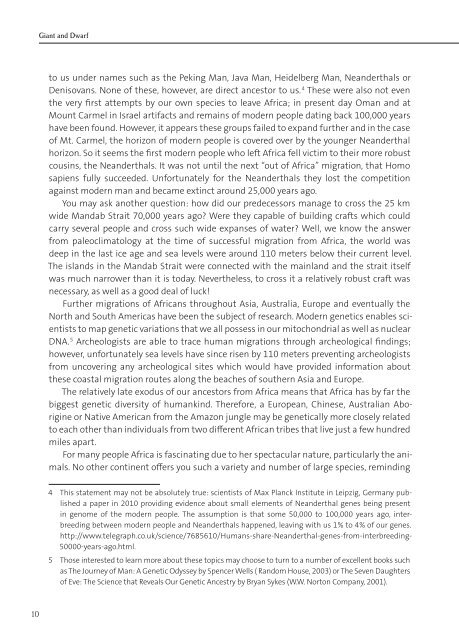Giant_and_Dwarf-FIN
Giant_and_Dwarf-FIN
Giant_and_Dwarf-FIN
Create successful ePaper yourself
Turn your PDF publications into a flip-book with our unique Google optimized e-Paper software.
<strong>Giant</strong> <strong>and</strong> <strong>Dwarf</strong>to us under names such as the Peking Man, Java Man, Heidelberg Man, Ne<strong>and</strong>erthals orDenisovans. None of these, however, are direct ancestor to us. 4 These were also not eventhe very first attempts by our own species to leave Africa; in present day Oman <strong>and</strong> atMount Carmel in Israel artifacts <strong>and</strong> remains of modern people dating back 100,000 yearshave been found. However, it appears these groups failed to exp<strong>and</strong> further <strong>and</strong> in the caseof Mt. Carmel, the horizon of modern people is covered over by the younger Ne<strong>and</strong>erthalhorizon. So it seems the first modern people who left Africa fell victim to their more robustcousins, the Ne<strong>and</strong>erthals. It was not until the next “out of Africa” migration, that Homosapiens fully succeeded. Unfortunately for the Ne<strong>and</strong>erthals they lost the competitionagainst modern man <strong>and</strong> became extinct around 25,000 years ago.You may ask another question: how did our predecessors manage to cross the 25 kmwide M<strong>and</strong>ab Strait 70,000 years ago? Were they capable of building crafts which couldcarry several people <strong>and</strong> cross such wide expanses of water? Well, we know the answerfrom paleoclimatology at the time of successful migration from Africa, the world wasdeep in the last ice age <strong>and</strong> sea levels were around 110 meters below their current level.The isl<strong>and</strong>s in the M<strong>and</strong>ab Strait were connected with the mainl<strong>and</strong> <strong>and</strong> the strait itselfwas much narrower than it is today. Nevertheless, to cross it a relatively robust craft wasnecessary, as well as a good deal of luck!Further migrations of Africans throughout Asia, Australia, Europe <strong>and</strong> eventually theNorth <strong>and</strong> South Americas have been the subject of research. Modern genetics enables scientiststo map genetic variations that we all possess in our mitochondrial as well as nuclearDNA. 5 Archeologists are able to trace human migrations through archeological findings;however, unfortunately sea levels have since risen by 110 meters preventing archeologistsfrom uncovering any archeological sites which would have provided information aboutthese coastal migration routes along the beaches of southern Asia <strong>and</strong> Europe.The relatively late exodus of our ancestors from Africa means that Africa has by far thebiggest genetic diversity of humankind. Therefore, a European, Chinese, Australian Aborigineor Native American from the Amazon jungle may be genetically more closely relatedto each other than individuals from two different African tribes that live just a few hundredmiles apart.For many people Africa is fascinating due to her spectacular nature, particularly the animals.No other continent offers you such a variety <strong>and</strong> number of large species, reminding4 This statement may not be absolutely true: scientists of Max Planck Institute in Leipzig, Germany publisheda paper in 2010 providing evidence about small elements of Ne<strong>and</strong>erthal genes being presentin genome of the modern people. The assumption is that some 50,000 to 100,000 years ago, interbreedingbetween modern people <strong>and</strong> Ne<strong>and</strong>erthals happened, leaving with us 1 % to 4 % of our genes.http://www.telegraph.co.uk/science/7685610/Humans-share-Ne<strong>and</strong>erthal-genes-from-interbreeding-50000-years-ago.html.5 Those interested to learn more about these topics may choose to turn to a number of excellent books suchas The Journey of Man: A Genetic Odyssey by Spencer Wells ( R<strong>and</strong>om House, 2003) or The Seven Daughtersof Eve: The Science that Reveals Our Genetic Ancestry by Bryan Sykes (W.W. Norton Company, 2001).10


